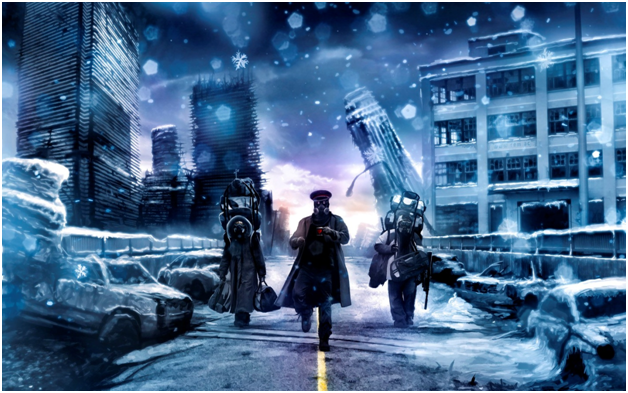I have often talked about nuclear winter following a nuclear war. In general, nuclear winter refers to so much dust and smoke being injected into the atmosphere that crops fail and billions of people die of starvation. It would mean the end of human civilization. Today I am going to report on a computer model that attempts to add detail to the idea of nuclear winter. Four research scientists conducted a study about what could happen as a result of a limited nuclear exchange such as a nuclear war between India and Pakistan. They both have about a hundred nuclear warheads. The study envisions a hundred nuclear warheads exploding over India and Pakistan.
Following a nuclear exchange between India and Pakistan, they estimate that five megatons of black carbon from fires is immediately thrown into the atmosphere. The carbon absorbs some of the radiation from the sun resulting in a drop in surface temperature and crop failures. Some of the carbon is washed out of the atmosphere by rain.
During the year after the nuclear exchange, the average surface temperature of the Earth drops by two degrees Fahrenheit. Within three years, the temperature has dropped another degree. After twenty years, the temperature will rise again but the surface of the Earth will still be one degree cooler than it was before the nuclear war.
As the temperature drops, the amount of rainfall decreases because cooler air holds less moisture. By the fifth year after the nuclear exchange, there will be nine percent less rainfall which will also impact crops. Even after twenty six years, the Earth will be getting four and a half percent less rain.
Between the second and the sixth year after the nuclear exchange, the frost free growing season will be shortened between ten days and forty days depending on the specific region.
There will be chemical reactions in the atmosphere because of the dust and soot thrown up by the war. One result of these chemical reactions will be the depletion of the ozone layer which shields people from the harmful ultraviolet radiation from the sun. Five years after the nuclear exchange, the ozone layer will be reduced by one fourth. Five years later, the ozone layer will still be eight percent less than it was before the war. As the ultraviolet radiation increases , there will be more sun burns and skin cancers. The radiation will also damage the DNA of plants and educe crop yields.
A separate study has estimated that up to two billion people could starve following an exchange of one hundred warheads resulting in crop failures caused by the dust and soot in the atmosphere.
It is obvious that the exchange of as few as a hundred warheads would result in the end of human civilization as we know it. The U.S. and Russia each have about four thousand warheads on missiles that target the other country and are ready to launch in minutes. There have already been mistakes that have almost resulted in the launch of these missiles. If one hundred warheads could end human civilization, then four thousand warheads would probably kill most of the human race and a great deal of plants and animals on Earth. This being true, the idea that the country being attacked would gain anything at all by launching a retaliatory nuclear strike is just absurd. The world must find a way to full nuclear disarmament before we destroy ourselves on purpose or by accident.
